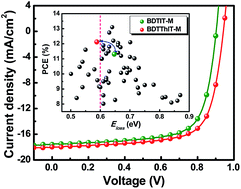Energy level modulation of non-fullerene acceptors enables efficient organic solar cells with small energy loss†
Abstract
Two new non-fullerene (NF) acceptors, namely BDTIT-M and BDTThIT-M, were rationally designed to optimize the energy levels and optical bandgap. BDTIT-M is derived by changing the end-group of NFBDT into slightly weak DCI-M, and BDTThIT-M is obtained by adding two conjugated thiophene side-chains into a ladder-type core of BDTIT-M. By incorporating with the polymer donor PBDB-T, BDTIT-M based organic solar cells (OSCs) deliver a higher PCE of 11.31% compared to that of NFBDT based cells, which is mainly attributed to the increased VOC and FF. A higher PCE of 12.12% with a small energy loss of ∼0.588 eV is achieved compared with BDTThIT-M based OSCs, benefiting from the elevated LUMO level, narrowed bandgap, and enhanced absorption coefficient and electron mobility of BDTThIT-M compared with BDTIT-M. The combination of a methyl-modified end-group and conjugated side-chain should be an efficient strategy to elevate the LUMO and HOMO levels with different amplitudes for realizing simultaneous improvement in VOC and JSC.



 Please wait while we load your content...
Please wait while we load your content...